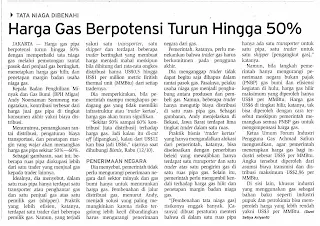The price of pipeline gas has the potential to drop by 50% by improving the gas trading system through cutting supply chains from multilevel gas sellers, fixing downstream gas prices, and setting the margins of gas commercial enterprises.
Head of the Oil and Gas Dissemination Agency (BPH Migas) Andy Noorsaman Sommeng said the biggest contribution from the selling price of piped gas at the end consumer level was distribution costs.
According to him, cutting the distribution chain, setting transportation costs, and setting reasonable margins will cut the price of pipeline gas by around 50% -60%. As an illustration, currently, several pipe segments are occupied by more than one trader who sells gas to other traders. Ideally, in one pipeline there is only one transporter or conveyor of gas and one gas seller for one gas owner (the shipper).
A more efficient practice there is one trader from several gas owners. But what happens is that one transporter, one shipper and there are several stratified traders that make the price expensive even if it is calculated from the average distribution fee of only US $ 0.5 to the US $ 1 per MMBtu of each trader. Andy estimates that if the government is able to remove gas traders who do not have the infrastructure or 'paper traders', gas prices will drop significantly.
"Around 50% to 60% of the contribution [distribution system] to gas prices. So if it is cut off, if from US $ 12 it could be the US $ 6. Andy said the government does not need to reduce state revenues from the oil and gas sector just to reduce gas prices. Improvement in the gas distribution channel, according to Andy, is the most possible solution because the risk is classified as smaller than having to reduce state revenues from gas.
The government needs to emphasize that gas traders must commit to the end-user. He considers traders cannot just be deleted in the gas supply chain. The reason is that the gas trading business actor acts as a liaison between gas producers and buyers. However, some traders only quote distribution costs in one gas pipeline.
As an illustration, Andy explained in Bekasi, West Java there are five levels of traders in one segment. The 'paper traders' business practices that rely solely on government allocations can be resolved by issuing regulations that require only one transporter and one trader for one gas sender in one gas pipeline. In addition, the government needs to take control of the downstream gas prices and determine the margin of the gas trading agency.
"Improving the risk of trading gas risks is not much. The way the minister made a regulation was that in one pipeline there was only one transporter for one pipe, one trader for one shipper, "he said.
If the government steps only reduce natural gas non-tax revenue (PNBP) and upstream activity efficiency, the maximum downstream gas price obtained is only US $ 8 per MMBtu. Downstream gas prices of US $ 6 cannot be obtained in this way even though the government is cutting all gas PNBP to compensate for gas prices.
Achmad Safiun, Chair of the Gas Industry Industry Forum, proposed that the government apply gas prices for the industry at the US $ 5 per MMBtu. This figure was obtained from the assumption of a maximum transmission and distribution cost of US $ 2.96 per MMBtu. Specifically for industries that use gas as raw material, such as the fertilizer and petrochemical industries, they can get a lower price of US $ 3 per MMBtu
Bisnis Indonesia, Page-30, Thursday, Oct 13, 2016.


No comments:
Post a Comment